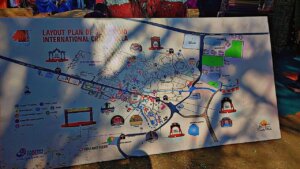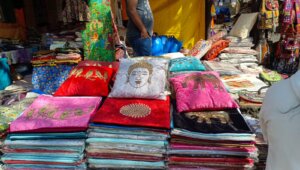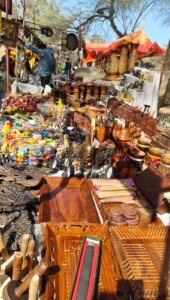Introduction
President Draupadi Murmu on Friday inaugurated the 37th edition of Surajkund International Crafts Mela – 2024 at Surajkund in Faridabad district. Haryana Governor Bandaru Dattatreya, Chief Minister Manohar Lal, Heritage and Tourism Minister Kanwar Pal, Union Minister of State for Heavy Industries Krishna Pal Gurjar and other dignitaries were present on the occasion.
Addressing the attendees, the President said that Tanzania being a partner country of the fair reflects India’s strong relations with the African Union. He said during talks with Tanzanian President Samia Suluhu Hassan in October last year, both countries agreed to further increase the scope of cultural exchange. He also highlighted that the fair will provide cultural programs as well as an opportunity to appreciate Tanzanian arts and crafts.
The President emphasized that Surajkund Mela celebrates the cultural diversity and traditions of India. He highlighted that the fair serves as a platform to connect artisans with arts and crafts enthusiasts.
Describing the fair as an art exhibition and a shopping mall, the President said that trade worth over Rs 20 crore is expected to be generated during the fair, presenting a significant opportunity for handicraft trade.
The Surajkund fair will continue till February 18.
Surajkund Mela 2024: Tickets & Layout Ground Map
Online: Book your tickets easily through BookMyShow by selecting your preferred date and enjoy the online experience.

Physical: Buy tickets from the designated counter at the Surajkund Mela venue. This option offers flexibility but there may be queues, especially at peak times.
Ticket prices:
Midweek pass: ₹120
Weekend Pass: ₹180
craft:
Crafts in India have immense cultural and historical importance. They are not just products; They are symbols of tradition, skill and heritage.
The Suraj Kund Mela showcases a wide variety of crafts from different regions of India, including ceramics, textiles, woodwork, metalwork, jewellery and more.

Each craft reflects the distinctive cultural identity of its region, displaying distinctive styles, motifs and techniques passed down from generation to generation.
By providing a platform for artisans to display and sell their crafts, Suraj Kund Mela plays an important role in preserving traditional crafts and supporting artisan communities.
The festival celebrates the intricate craftsmanship and artistic excellence inherent in Indian craftsmanship, promoting cultural exchange and awareness.
Cooking:
Indian cuisine is celebrated for its vast diversity, intricate flavor profiles, and vibrant array of aromatic spices, serving as a cornerstone of the nation’s cultural heritage.
Suraj Kund Mela offers an immersive experience into the intricate tapestry of regional cuisines spanning across India, inviting visitors on a delectable journey through the country’s culinary landscape.
This festival serves as a dynamic platform for local chefs and culinary artisans to present their authentic dishes and time-honored cooking techniques, ensuring the preservation and transmission of age-old culinary traditions to future generations.
Through the medium of food, attendees not only tantalize their taste buds but also glean insights into the cultural significance of various ingredients, culinary methods, and gastronomic customs, fostering a deeper appreciation for India’s rich culinary heritage.
Culture:
Culture includes a broad spectrum of traditions, rituals, beliefs, arts and customs that define a society. It is the backbone of a nation’s identity and heritage.
Suraj Kund Mela celebrates India’s cultural diversity through live performances, music, dance and theatre, showcasing the country’s rich artistic traditions.
The festival’s cultural activities provide a platform for artists, musicians, dancers and performers to share their talents and connect with audiences around the world.
The festival promotes cultural exchange and dialogue, fostering mutual understanding and appreciation of India’s diverse cultural heritage.
Through crafts, cuisine and cultural exhibitions, the Suraj Kund Mela offers visitors a holistic experience that celebrates the essence of Indian culture and fosters a sense of pride in the country’s artistic and culinary traditions.
Crafts at Surajkund Mela 2024
fabric:
Surajkund Mela offers a wonderful variety of textiles including handwoven sarees, shawls, dupattas and cloth pieces.

Each region of India has its own traditional weaving techniques, such as Banarasi silk from Varanasi, Pashmina shawls from Kashmir, and Kantha embroidery from West Bengal.
Visitors can explore the richness of Indian textiles through intricate patterns, vibrant colors and luxurious fabrics, reflecting the cultural heritage of each region.
Pottery and Ceramics:
The Mela offers a wide range of pottery and ceramics, including terracotta, clay and ceramic artifacts.
Artisans create exquisite pots, vases, figurines and decorative objects, demonstrating traditional clay techniques passed down from generation to generation.
Each piece of ceramic reflects the unique aesthetic sensibility of its region with distinctive styles, motifs and designs inspired by local traditions and folklore.
Carpentry and Carving:
The Surajkund Mela showcases the skill of Indian artisans and wood carvers who transform raw wood into intricate sculptures, furniture and decorative objects.
Artisans use traditional carving techniques to create elaborate patterns, motifs and designs, often depicting scenes from mythology, nature and everyday life.
Visitors can admire the craftsmanship and skill involved in wood carving, as well as the beauty of the wood’s natural grain and texture.
Metallurgy:
Metalworking is an important feature of the Surajkund Mela, where artisans showcase their expertise in brass, copper, silver and other metals.
Visitors can marvel at the complexity of the silver working, stamping, engraving and casting techniques used to create ornate vessels, sculptures, jewellery and decorative objects.

Each piece of metal reflects the cultural heritage and craftsmanship of its region, with unique designs and motifs inspired by local traditions and folklore.
Jewellery and Accessories:
The Mela offers a dazzling array of traditional Indian jewellery including gold, silver and bead jewellery.
The artisans showcase a variety of jewellery making techniques such as Kundan, Meenakari, Thewa and temple jewellery, each with its own unique style and craftsmanship.
Tourists can explore the beauty and symbolism of Indian jewellery with intricate designs inspired by nature, mythology and religious motifs.
Cuisine at Surajkund Mela 2024
North Indian Cuisine:
North Indian cuisine is known for its rich and flavourful dishes, often using aromatic spices such as cumin, coriander and garam masala.
At the Surajkund Mela, visitors can taste iconic North Indian dishes such as butter chicken, paneer tikka, dal makhani and different types of breads such as naan, roti and paratha.
The cuisine of states like Punjab, Uttar Pradesh, Rajasthan and Delhi offers a delicious mix of vegetarian and non-vegetarian options, showcasing the culinary diversity of the region.
South Indian Cuisine:
South Indian cuisine is known for its use of rice, coconut, and a variety of legumes, as well as its distinctive Flavors and cooking techniques.
At the Mela, visitors can enjoy classic South Indian dishes like dosa, idli, vada, sambar, rasam and a variety of rice preparations like biryani and pulao.
The cuisine of states like Tamil Nadu, Kerala, Karnataka and Andhra Pradesh offers a wide range of vegetarian and non-vegetarian options, including seafood specialties and spicy curries.
East Indian Cuisine:
East Indian cuisine is characterized by its use of mustard oil, fish and rice, as well as its subtle but delicious blend of spices.
Visitors can try cuisine from states like West Bengal, Odisha, Bihar and Jharkhand, including iconic dishes like fish curry, macher jhol, litti chokha and a variety of sweets like rasgulla and sandesh.
The cuisine reflects the cultural influences and culinary traditions of the region, focusing on fresh, locally sourced ingredients and simple but delicious preparations.
Antillean cuisine:
West Indian cuisine is known for its bold Flavors, use of seafood and coconut, and a variety of spicy and spicy dishes.
At Surajkund Mela, visitors can enjoy cuisine from states like Maharashtra, Gujarat, Goa and Rajasthan, including favourites like pav bhaji, dhokla, thepla, vada pav and seafood dishes like fish curry and prawn masala.
The cuisine reflects the diverse cultural heritage and culinary traditions of the region, with influences from the Portuguese, Mughal and indigenous communities.
Street food and snacks:
Apart from regional cuisine, Surajkund Mela also offers a variety of street food and snacks from across India, including chaat, pakoras, samosas and bhel puri.
Visitors can experience India’s vibrant street food culture, with vendors serving freshly prepared snacks and dishes that are delicious and affordable.
Street food stalls offer a taste of the bustling markets and vibrant Flavors found in cities and towns across the country, making Surajkund Mela a culinary adventure for food lovers.
Cultural Attractions
Cultural Show:
The Surajkund Mela presents a wide range of cultural performances showcasing the rich and diverse traditions of India.
These performances often include folk dances, theatrical presentations, storytelling sessions, and re-enactments of traditional rituals and ceremonies.
Cultural artists come from different regions of India and represent different castes, languages and communities, giving visitors an insight into the country’s cultural mosaic.
The performances celebrate themes such as love, friendship, bravery, devotion and the victory of good over evil, resonating with audiences of all ages and backgrounds.
Musical show:
Music plays a central role in Indian culture and serves as a medium of expression, storytelling and celebration.
Surajkund Mela organizes various music programs featuring traditional and contemporary Indian musical styles including classical, folk, devotional and fusion.
The audience can enjoy fascinating performances by talented musicians playing the sitar, tabla, flute, veena and other instruments like the dholak.
Music programs often include elements of improvisation, audience participation and storytelling, creating an intense and engaging experience for listeners.
dance performance:
Dance is an integral part of Indian culture, with a wide variety of classical, folk and contemporary dance forms practiced throughout the country.
Surajkund Mela presents captivating dance performances that highlight the elegance, beauty and diversity of Indian dance traditions.
Tourists can witness classical dance forms like Bharatnatyam, Kathak, Odissi and Kathakali as well as folk dances like Bhangra, Garba, Dandiya and Ghoomar.
Dance performances often feature colourful costumes, intricate choreography, and expressive storytelling, conveying themes of love, devotion, nature, and mythology.
Workshops and Demonstrations:
In addition to exhibitions, Surajkund Mela offers workshops and demonstrations where visitors can learn about various aspects of Indian culture such as traditional arts and crafts, music, dance and cuisine.
These interactive sessions provide hands-on learning opportunities, allowing participants to interact with skilled artisans, musicians, dancers and cooks.
Workshops and performances promote cultural exchange and appreciation, leading to a deeper understanding of India’s artistic heritage and traditions among visitors from around the world.
Participants can gain knowledge about the techniques, skills and cultural significance of various art forms, enhancing their overall experience at Surajkund Mela.
Immersive Experiences
Arrival and first impression:
Describes the author’s arrival at the Surajkund Fair, including the atmosphere of the place, the crowd and initial impressions.
Share any memorable moments or observations he had upon entering the festival grounds, such as the vibrant colors, lively music, and captivating aromas wafting through the air.
Explore craft and artisan stalls:
Take readers on a journey through the various craft stalls at Surajkund Mela, sharing anecdotes about unique finds, interactions with artisans and memorable purchases.

It describes extraordinary performances or performances that left a lasting impression, such as watching a master craftsman at work or discovering a rare and exquisite work of art.
Culinary Adventures and Flavour:
Share the experience of trying the various regional cuisines and dishes available at Surajkund Mela, highlighting favourite dishes, flavours and unexpected culinary discoveries.
Describe any memorable encounters with food vendors, chefs, or fellow food enthusiasts, as well as any interesting stories or anecdotes related to trying new foods or flavours.
Intensive Cultural Experience:
Consider attending the cultural performances, musical performances and dance programs at the Surajkund Mela, sharing the impact of the show, the atmosphere and the audience reactions.
Describe any extraordinary moment or performance that resonated with the author, whether it be a mesmerizing dance performance, a moving musical performance, or a captivating storytelling session.
Interact with artisans and artists:
Share anecdotes about connecting with artisans, artists and cultural enthusiasts at Surajkund Mela through talks, workshops or collaborative activities.
Highlight any memorable conversations, exchanges of knowledge, or shared experiences that have enriched the author’s understanding of Indian culture, crafts, and traditions.
Thoughts and conclusion:
Conclude the section by considering the overall experience of participating in Surajkund Mela 2024 and its impact on the author.
Share any ideas, lessons learned or personal connections you made during the festival, as well as ideas about the importance of preserving and celebrating cultural heritage through events like the Surajkund Mela.
Impact and Importance
Cultural importance:
The Surajkund Mela is a celebration of India’s rich cultural heritage, showcasing the diversity of crafts, cuisine, music, dance and traditions from different regions of the country.
The festival serves as a platform for artisans, musicians and artists to showcase their talents, preserve and promote traditional art forms and cultural practices.
The Surajkund Mela promotes cultural exchange and dialogue, bringing together people from diverse backgrounds to appreciate and learn about India’s cultural diversity.
Through cultural performances, workshops and demonstrations, the festival helps educate and inspire visitors about the importance of Indian culture and its role in shaping society.
Economic importance:
The Surajkund Mela contributes significantly to the local and regional economy, generating income and employment opportunities for artisans, vendors and businesses.
The festival attracts a large number of national and international visitors, who spend money on tickets, crafts, food, accommodation, transportation and other goods and services.
Surajkund Mela offers an attractive market for artisans to sell their products directly to consumers, eliminating middlemen and ensuring fair prices for their craftsmanship.
The festival promotes tourism in the area, attracting visitors from all over and supporting local hotels, restaurants, shops and other businesses.
Social importance:
The Surajkund Mela plays an important role in promoting social unity and community bonds, bringing people together to celebrate shared traditions and cultural experiences.
The festival provides opportunities for social interaction, networking and cultural exchange between visitors, artisans, artists and participants from diverse backgrounds.
The Surajkund Mela serves as a platform for cultural diplomacy and international cooperation, promoting understanding and goodwill between different countries and cultures.
By focusing on traditional crafts, cuisine and culture, Surajkund Mela promotes pride in Indian heritage and identity, strengthens social bonds and fosters a sense of belonging among participants and attendees.
Conclusion
cultural heritage:
The Surajkund Mela is a testament to India’s rich and diverse cultural heritage, showcasing the country’s vibrant traditions, art forms, crafts, cuisine and performing arts.
The festival serves as a living repository of India’s cultural heritage, preserving and promoting traditional practices passed down from generation to generation.
The Surajkund Mela celebrates the enduring beauty and resilience of Indian culture, providing a window into the country’s ancient traditions and contemporary expressions.
Unity in diversity:
Surajkund Mela symbolizes the spirit of unity in diversity, bringing together people from different regions, languages, religions and communities to celebrate their shared cultural identity as Indians.
The festival works to merge cultures by promoting mutual understanding, respect and appreciation between participants and attendees of different backgrounds.
The Surajkund Mela exemplifies the idea of India as a blend of cultures, where diversity is not only tolerated but celebrated as a source of strength and prosperity.
Global appeal:
The enduring appeal of the Surajkund Fair extends beyond national borders, attracting visitors and participants from around the world who are drawn to its vibrant atmosphere, cultural spectacles and immersive experiences.
The festival acts as a bridge between cultures, promoting international exchange, dialogue and cooperation in a spirit of cultural diplomacy and mutual appreciation.
The global reach and impact of Surajkund Mela contributes to India’s soft power, enhancing its reputation as a cultural superpower and symbol of diversity and inclusion.
Legacy and Continuity:
The enduring appeal of the Surajkund Fair lies in its ability to adapt and evolve with the times while remaining true to its core mission of celebrating India’s heritage and diversity.
The festival’s legacy spans decades, and each edition builds on the successes of previous years and introduces new elements to keep the experience fresh and engaging.
Surajkund Mela serves as a cultural institution, inspiring future generations to appreciate and preserve India’s rich cultural heritage by embracing innovation and creativity.
Ultimately, the enduring appeal of the Surajkund Fair as a celebration of India’s heritage and diversity lies in its ability to create a sense of pride, wonder and unity among participants and attendees, transcending the boundaries of time, place and culture. As a symbol of India’s cultural richness and resilience, Surajkund Mela shines as a symbol of hope, inspiration and cultural exchange in an increasingly interconnected world.

